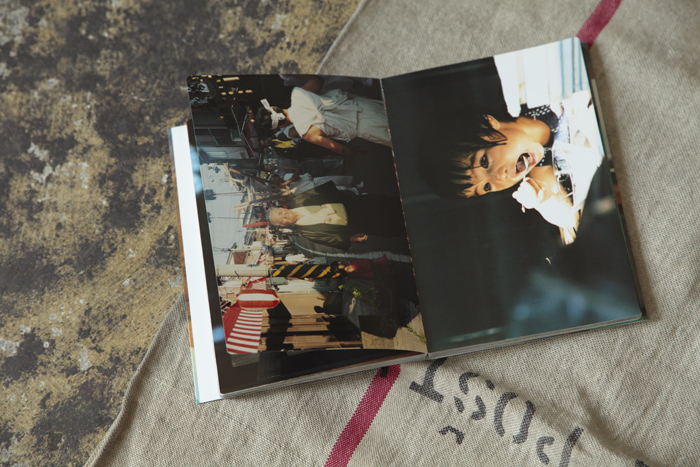「筑豊の貧困を、社会の矛盾を訴えるために、子どもを利用している。子どもは非常に環境を映すよね。だからやり口としては成功している。写真に訴求力があるもの」
これは、荒木経惟が、土門拳『筑豊のこどもたち』(築地書館)に関して、雑誌『太陽』(平凡社)のなかで述べた言葉です。この言葉を、「写真家は、自分の見せたい世界観を、子どもを使って現すことができる」と解した私は、以来、「子ども」の写真集に興味を持つようになりました。
「子ども」は多くの写真家の心を捉えた被写体のようで、多種多様な「子ども」の写真集が存在します。例えば、土門拳とよく比較され、ライバル関係にあった木村伊兵衛の処女出版は、日本の子どもを写した『Japanese school life through the camera』(国際文化振興会)でした。荒木経惟もまた、最初に刊行した写真集は、自画像とも称される、東京の下町のこどもを活写した『さっちん』(新潮社)でした。
荒木経惟の上の言葉を踏まえて撮影したのではないだろうか、と思いたくなるのが、ホンマタカシの『東京の子供』(リトルモア)です。2001年に出版された写真集ですが、写されているのは、目が虚ろだったり、いまにもキレそうな子どもたちだったりで、写真家が考える時代の矛盾を、「子ども」の姿をかりて、あぶりだしていると思えたからです。
川島小鳥の『未来ちゃん』(ナナクロ社)もまた、子どもの写真集です。写された「未来ちゃん」は、服装やはな垂れの具合から、現代の子どもではなく、昭和の子どもという印象を持ちます。 ありのままで飾り気のない「未来ちゃん」。いつも愛くるしい「未来ちゃん」。それ故、ページをめくる度に、いまの世知辛い世のなかの希望のように思えてきます。ホンマタカシが写した子どもとは対極にある子ども。
つまり、本書は、荒木経惟の言葉を逆手にとった本なのではないかと思うのです。すなわち、「社会の希望を訴えるため、子どもを利用している」写真集であると。また、そう考えると、『未来ちゃん』というタイトルにも頷くことができます。
 PHOTOGRAPHY BY KAZUO MINATO
PHOTOGRAPHY BY KAZUO MINATO
“He uses its children in order to call out society's contradiction, Chikuho's poverty. Children reflect their environment remarkably. That's why they are successful in achieving his goal. His photos are appealing.”These are the words Nobuyoshi Araki spoke in the magazine “Taiyo” (Heibonsha) about Ken Domon's “Chikuho no kodomotachi”(Tsukiji Shokan). I construed his words as, “Photographers can show the world view they want through children.” Ever since then, I've been interested in “children” photograph collections.
“Children” are subjects that have captivated the minds of many photographers. Many “childrens” photograph collections exist. For example, Ken Domon's rival who was often compared to him, Ihei Kimura and his first publication showing Japanese children“Japanese school life through the camera” (Kokusai Bunka Shinkokai) or Nobuyoshi Araki's first published photograph collection, referred to as his self-portrait, vividly depicting children in Tokyo's Shitamachi, “Sacchan”(Shinchosha).
In keeping with Nobuyoshi Araki's words above, Takashi Honma's “Tokyo's Children” (Littlemore) is what it seems he has shot. Published in 2001, what is shot are vacant eyes or children who look like they're about to lose it, and it seems to bring out what photographers felt were the time's contradictions through “children”.
Kotori Kawashima's “Mirai-chan” (Nanarokusha) is also a children's photograph collection. From the photographed “Mirai-chan's” snot-nosed and western-clothes appearance, we get the impression that she's not a modern child but rather a Showa child. The unaffected, au naturel “Mirai-chan”. The adorable “Mirai-chan”. She consequently looks like a light of hope in the current cold world as you flip through the pages. The children Takashi Honma photographs are the antithesis of children. That is, the book stands Nobuyoshi Araki's words on their head—i.e., that it's a photograph collection that “uses children to bring out society's hope”. When viewed this way, we can nod at the title “Mirai-chan”.*
*Note: the Japanese girl's name “Mirai” also means “future” in Japanese.
 PHOTOGRAPHY BY KAZUO MINATO
PHOTOGRAPHY BY KAZUO MINATO

 PHOTOGRAPHY BY KAZUO MINATO
PHOTOGRAPHY BY KAZUO MINATO